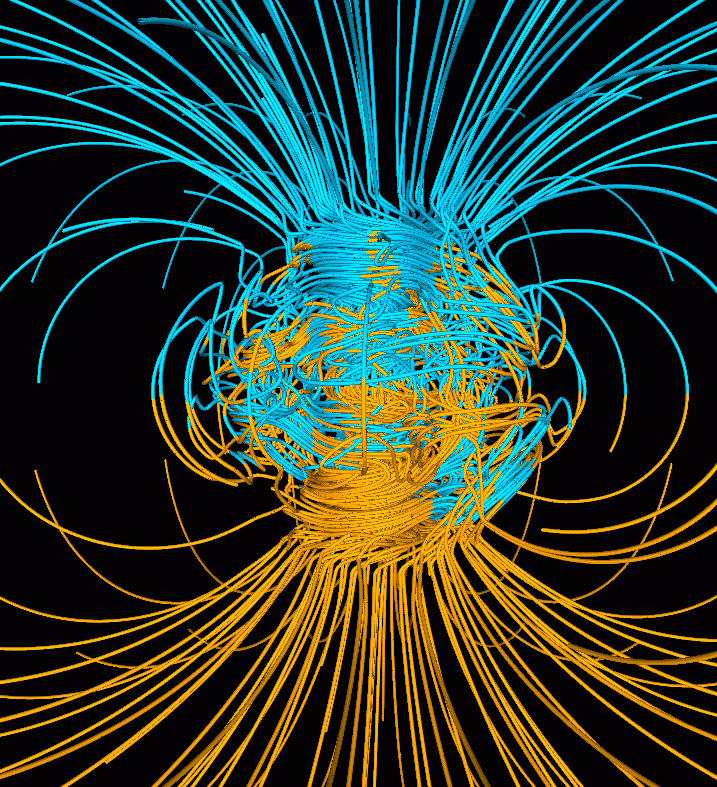
Anthropogenic Disturbances in Geomagnetic Observations
Abstract
The aim of this project is to identify and rectify interference to measurements of the geomagnetic field that is caused by human activity. Continuous measurement of the Earth’s magnetic field is taken at many geomagnetic observatories across the globe. The South African National Space Agency (SANSA) operates a number of these across South Africa and Namibia. These measurements are used to identify long-term changes in the geomagnetic field and short-term changes due to solar activity. Unfortunately, many human activities have magnetic signatures that are detected by the sensitive magnetometers employed at geomagnetic observatories. Your task is to design a data processing pipeline to automatically identify anthropogenic disturbances, and to isolate and remove these components from magnetometer signals with as little as possible impact on the natural components of the signal.
Problem Statement
Geomagnetic sensors (i.e. magnetometers) react to wanted and unwanted sources of magnetic field. The “wanted” sources of magnetic field are the internal and external components of the geomagnetic field such as the geomagnetic dynamo and solar activity, respectively.
Unwanted sources of magnetic field are typically due to human (or anthropogenic) activity. These include interference from power grids and other electrical equipment, switching on railway lines, movement of vehicles or other ferromagnetic materials near the sensor. See the figure below.
Since geomagnetic observatories are interested in accurately capturing the geomagnetic field, and natural perturbations thereof, identifying and removing the unwanted components of the signal is an important task. Typically, this involves geomagnetic field experts manually identifying and removing the offending components of the signal by filtering, interpolating, or cutting. This task is time-consuming and tedious.
Two examples of anthropogenic interference at the Hartebeesthoek observatory (HBK, South Africa) and the Entoto observatory (ENTO, Ethiopia). Both observatories experienced noise from nearby railways. Note how the disturbance at HBK ceases on 27 July (a Sunday).
Aim
The broad aim of this work is to design a framework for the automatic identification of anthropogenic signal geomagnetic field observations.
Specifically, the aims are to:
- Describe the typical sources of anthropogenic disturbance (AD) as seen in GMF data.
- Characterize the disturbances in terms of their spectral and temporal characteristics.
- Describe, adapt, and develop methods to accurately identify components in the data that are due to anthropogenic activity.
- Describe, adapt, and develop methods to adequately isolate and remove anthropogenic components from the data.
Methodology
- Utilize a data set of labelled AD events and published literature to describe typical sources of AD.
- Use spectral analysis and statistical methods to systematically characterise stationary and transient disturbances.
- Show how these disturbances can influence observatory products such as local geomagnetic disturbance indices (e.g. local K-index).
- Utilise the spectral characterisation of various sources of AD to automatically identify portions of the signal that are due to AD. Techniques from signal processing, filter design and machine learning could be used to achieve this. It is up to the student to select appropriate methods.
- Utilise signal processing techniques to adequately remove AD from the signal, where possible. It may not be possible for all sources to be removed from the signal.
- Compare results with manually processed GMF observations and report on the accuracy of the automated procedure.
Deliverables
- Submitted thesis manuscript detailing all aspects of the project, including literature review, analysis and results.
- Software to perform the analysis reported in the thesis manuscript. We prefer the code be written in Python (version 3.x), but other options can be discussed.
- Software to enable the processing pipeline described in the manuscript.
- Documentation for the processing tool.
Resources
Data
Unprocessed and processed GMF data to be supplied by SANSA Hermanus.
Software
Some analysis software may be supplied by SANSA but the candidate will be expected to largely develop all the software to enable the processing pipeline.
Bibliography
Access to academic literature and a list of relevant papers will be provided by SANSA and the relevant academic institutions.


